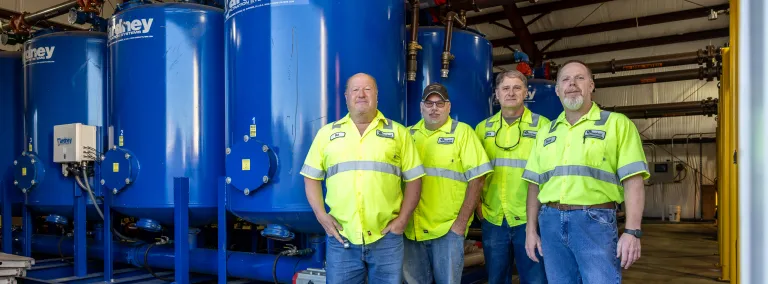SURF’s WWTP laboratory passes annual EPA proficiency testing
For the past 17 years, SURF's Wastewater Treatment Plant has treated more than 10 billion gallons of water—with no permit violations. This excellent track record is thanks to a dedicated team who continually monitor the treatment process.
Pick any date in the last 17 years of water treatment at SURF, and you’ll find water quality data. That’s because the water treated and discharged from SURF is monitored continuously - 24 hours a day, 365 days a year. Four people are responsible for ensuring the water discharged from SURF continuously meets the stringent requirements needed to support healthy aquatic life downstream.
“Our two main water pollutants are iron and ammonia,” said Dave Johnson, wastewater treatment plant superintendent at SURF. Johnson explained that hot water pumped from the underground lab spaces is mixed with colder water from the nearby Grizzly Gulch tailings impoundment on the surface.
Some of the iron present in the water at SURF is leached from the rock itself, while some comes from the rusting of iron workings left behind when the former mine closed. The small amounts of ammonia in the water come from previous blasting and gold processing activities. Johnson and his team are licensed operators who must maintain the specific skillset needed to ensure the plant is operating at the highest standards.
“Every day we’ll do at least two ammonia checks on that water. We’ll do a grab sample for the instant ammonia, and then we’ll also do a composite sample, which covers the entire 24-hour period of discharge. We make sure those levels stay below the threshold that is required,” Johnson said.

At SURF, bacteria are utilized to pull some of the pollutants from the water. SURF’s treatment plant operators also monitor this system.
“Every day we also analyze the total suspended solids. Our filters are catching any sludge left by the bacteria used to treat the water. And so, we’re measuring how much is getting through the filters and going down the creek to make sure we are within the limits,” said Doug Coolley, a wastewater treatment plant operator at SURF.
Each year, the onsite lab at SURF is required to complete Environmental Protection Agency (EPA) proficiency testing to ensure the integrity of analytical results. The data collected from analyzing water treated by the WWTP is used to document compliance with the facility’s Clean Water Act discharge permit.
Wastewater treatment plant operators at SURF undergo the proficiency testing to demonstrate they can accurately analyze environmental samples. The EPA mandates that accredited laboratories, such as SURF’s water treatment lab, analyze “unknown” samples provided by an external proficiency testing provider. This process ensures the reliability and validity of environmental data used to comply with permits.
SURF’s water treatment operators were tasked to analyze “unknown” samples for pH, total suspended solids, and ammonia. The results were submitted, and SURF once again passed the proficiency testing, ensuring the onsite lab remains EPA accredited and can continue to analyze water discharged from the WWTP.
“Our WWTP team repeatedly goes above and beyond the minimum requirements. They are great stewards of the environment, and for this we should all be proud,” said Tim Baumgartner, director of surface operations and utilities at SURF.
